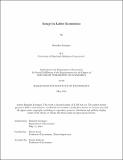Essays in Labor Economics
Author(s)
Enriquez, Brandon
DownloadThesis PDF (3.829Mb)
Advisor
Autor, David
Terms of use
Metadata
Show full item recordAbstract
This thesis consists of four chapters on the economics of labor markets. The f irst, joint with Fidan Ana Kurtulus, evaluates the employment effects of the Japanese trade shock of the 1960s-1980s, and whether they were racially disparate. Most importantly, we test whether differential occupational exposure drove racially disparate effects. Using detailed establishment-level data and a shift-share instrumental variables design, we find that the shock caused substantial decreases in overall manufacturing employment and in Black manufacturing operator employment. We find that two-thirds of the decrease in Black operator employment (relative to that of white operators) was due to disparate occupational exposure. Disparate exposure wasassociated with local anti-Black prejudice. The Japan shock decreased Black income in affected areas, and had persistent effects on Black poverty and joblessness. Taken together, these results show that aggregate sector-level trade shocks can hit minority workers particularly hard when they are concentrated in exposed occupations. The second, joint with Anthony DeFusco and Maggie Yellen, is documents facts about wage garnishment. Wage garnishment allows creditors to deduct money directly from workers’ paychecks to re pay defaulted debts. We document new facts about wage garnishment between 2014–2019 using data from a large payroll processor who distributes paychecks to approximately 20% of U.S. private-sector workers. As of 2019, over one in every 100 workers was being gar nished for delinquent debt. The average garnished worker experiences garnishment for five months, during which approximately 11% of gross earnings is remitted to their creditor(s). The beginning of a new garnishment is associated with an increase in job turnover rates but no intensive margin change in hours worked. The third, joint with Damon Jones and Ernie Tedeschi, is on employment effects of the the Child Tax Credit. We estimate the extensive and intensive margin labor supplyresponse to the monthly Child Tax Credit disbursed in 2021 as a part of the American Rescue Plan Act. Us ing Current Population Survey microdata, we compare labor supply outcomes among households who qualify for varying relative increases in household income, as a result of their income level and household size. We do not find strong evidence of a change in labor supply for families receiving the credit. The results are robust to alternative labor supply models, where households respond mainly to cash on hand or changes in the annual budget set The final, joint with David Autor, is on employment effects of pandemic unemployment insurance. In response to the economic devastation caused by the COVID-19 pandemic, the fed eral government creased the Federal Pandemic Unemployment Compensation Program (FPUC), which expanded unemployment insurance benefits by $600 per week. Complementarytopriorworkonpandemicunemploymentbenefits,westudythe effects of FPUC on firm payrolls. We find that FPUC had large effects on small business employment and reopening. Our estimates suggest that the FPUC reduced employment by approximately 1 million workers, or about 0.5 percent of firm payrolls. Our results establish that increases in the unemployment insurance replacement rate are likely to be particularly impactful for small and low-wage firms, both because these benefits have a greater incentive effects for low-wage workers and because small firms cannot readily smooth out the uncertainty in filling vacancies. JEL Codes: J01, J15, J65, J22, G51
Date issued
2024-05Department
Massachusetts Institute of Technology. Department of EconomicsPublisher
Massachusetts Institute of Technology